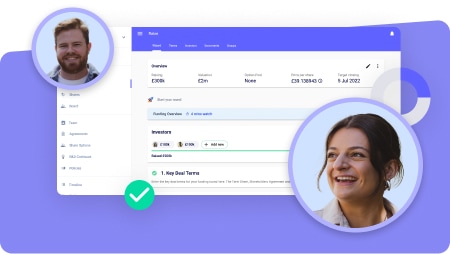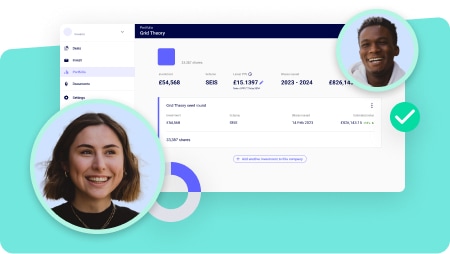Read transcript
Meera: Amazing, brilliant – welcome, everyone! I am going to hand over to Aaron, one of our wonderful account managers here, who is going to kick off and run you through how to close your funding round before the end of the tax year. Over to Aaron.
Aaron Duke: Thank you very much, Meera, and welcome, everybody! I hope you’re all doing well. As Meera just introduced, today’s webinar is about how to close your funding round before the end of the tax year. It’s a fitting topic, as this is the busiest time of year for fundraising in the UK market.
Just a quick note – this webinar is being recorded, and we aim to send out the recording by the end of the week, along with a copy of the deck. That way, you’ll have everything on hand. I’m looking forward to jumping into this with you all. Please note that for questions, we have different QR codes throughout the deck. You can scan them to submit questions, and at the end of the webinar, we’ll have about five minutes to answer four or five of them. If we don’t get to your question, we’ll also provide guidance on how to submit additional queries after the webinar.
This is part two of a three-part webinar series. Part three will take place on March 11 and will focus on R&D, featuring my colleagues Mike and Ben. If you’d like to sign up, you can scan the QR code on the screen now, or you’ll also find the event listed on our website.
Bethan Hill: Hi, lovely to meet you! Today’s agenda: we’ll start with a brief introduction to Aaron and myself, then cover why you should close your round before the end of the tax year. We’ll also go over the funding vehicles available to help you do that and explain what it means to “get your ducks in a row.”
Aaron Duke: Perfect. As I mentioned, we have QR codes throughout the deck where you can submit questions. We’ll answer them at the end of the webinar.
Bethan Hill: Amazing – back over to me! My name is Bethan – it’s a Welsh name, but I also answer to Beth if you put that in the chat. I’m a Funding and Equity Strategist at SeedLegals. I’ve been here for over two years and have helped more than 650 founders like you start their funding rounds. This is my third Q1 at SeedLegals, and I always love this time of year. I’m excited to share some insights with you today.
Aaron Duke: Awesome. I’m Aaron, an Account Manager at SeedLegals. I’ve worked in fundraising for the past three years – first in VC partnerships, and now at SeedLegals, where I work more closely with founders. I’ve been here for almost a year now, so this is technically my second Q1, as I joined toward the end of last year’s. Given the time of year and the urgency of closing before the end of the tax year, this is a very relevant webinar.
As we kick things off, the big question everyone wants answered is: why should you close your round before the tax year?
Bethan Hill: Thanks, Aaron. Briefly, this is the best time of year to attend a webinar on how to close your funding round. We’re currently in the busiest fundraising period of the year. I always say this is the only time of year when investors feel as much urgency as founders do to close a round. Investor appetite is at its peak right now – before the new financial quarter starts, before people go on holiday, and before they set their annual goals and plan for the year ahead in May.
You can see this urgency reflected in the data Aaron has shared on the screen. These insights are based on the one in five UK funding rounds that we support at SeedLegals. There’s a spike in December as some founders try to close by the end of the calendar year. However, there’s an even bigger spike – 100% increase in activity – leading up to the end of the tax year.
To take advantage of this trend, early preparation is key. Maximizing your timeline allows you to make the most of the current surge in investor appetite. The most important thing is ensuring that your round is closed, and shares are issued to investors before the tax year ends. We’ll break down exactly how to do that throughout this webinar.
Aaron Duke: Perfect, thanks, Bethan. We’ve covered why closing before the end of the tax year is so important – particularly in relation to SEIS and EIS eligibility and the general increase in investor activity. Now, let’s move on to the next key topic: what funding vehicles do you have at your disposal?
What is a funding vehicle, how do you use it, and when should you use it? Essentially, a funding vehicle is the legal mechanism that allows you, as a founder, to accept investment. We’ll be diving into three different funding mechanisms, looking at their pros and cons, and explaining when they are most useful.
The first one we’ll cover is the SeedFAST. We call it a SeedFAST at SeedLegals, but in the wider market, this is known as an ASA (Advanced Subscription Agreement).
In short, investors commit to subscribing for shares in your next funding round in exchange for cash upfront. The key benefit here is that you receive funding now, rather than just having verbal commitments or a signed term sheet. This allows you to bank capital early, which can be crucial for growing your business.
Some of the main reasons founders choose a SeedFAST include:
- Delaying valuation decisions: If you’re at an early stage and setting a valuation is tricky, a SeedFAST allows you to finalise your valuation later. Since it’s a convertible mechanism, no shares are issued until a conversion event occurs (either inside or outside of a formal funding round).
- Raising smaller amounts upfront: You don’t need to wait until you’ve secured a full round to start raising.
- Securing investor commitments quickly: Unlike traditional funding rounds, where you might be waiting on due diligence, SeedFAST agreements allow you to lock in investor commitments and receive funds immediately.
- Fast and simple process: Since the SeedFAST is a single-document agreement per investor, there’s no need for lengthy shareholder agreements or deeds, making it much faster to complete.
- Flexibility: You have two options for conversion – inside or outside a funding round.
- SEIS/EIS eligibility: Per HMRC rules, SeedFASTs must be converted into shares within six months to remain eligible for SEIS/EIS tax relief.
Aaron Duke: Then you move over to your priced equity funding round, right? This is the most common type of fundraising round you’ll hear about. A priced equity fundraising round has multiple steps, which we’ll go through, but before we jump into those, the way I always like to describe a priced equity round is that it’s like a bus. Ultimately, you’re trying to get all your investors onto the bus, every seat booked, but until every single seat is booked, the bus doesn’t go anywhere – it can’t move. Whereas, if we go back to our SeedFAST, that’s more like individual taxis – they can leave at different points as soon as the individual investor is ready.
Within your priced equity fundraising round, the first step is what’s called the term sheet. That’s your starting point, and it’s really the negotiation stage. This is where you’ll be negotiating valuations, share prices, and any smaller terms at this point.
The term sheet itself is not a legal document.
[Interruption] Oh – can I just ask everybody to make sure they’re on mute? I’m getting some feedback on my side.
[Pause]
Okay, awesome. So, then you move on to the shareholders’ agreement – and now this is the legally binding document. Every single investor in the round needs to agree to and sign the shareholders’ agreement, because this is what formally brings all those who committed via the term sheet into the legal mechanism of the priced equity round. This is where you stipulate different terms and outcomes.
This is part of what’s referred to as long-form documentation.
Next, you’ve got the disclosure letter, which all new shareholders will need to sign. This is really there to protect you and the company and to ensure transparency around things like debts.
Then you’ve got your articles of association – this is the rule book. If you’re looking to set up an option scheme, growth shares, or anything similar, those would typically be outlined in the articles of association.
Just a point on the articles of association – they don’t need to be signed. The only documents that need to be signed at this stage are the disclosure letter and the shareholders’ agreement, and these are what can ultimately delay closing the round because you need everyone to be aligned and in agreement before signing.
After the articles of association, you’ve got shareholders’ resolutions. These normally need to be signed by at least 75% of shareholders, as they authorise the issuance of new shares. Then you’ve got board resolutions, which are essentially corporate governance – the board signs off to formally approve the closing process of the round.
Once the resolutions are complete, that’s when you can start taking in capital. So, going back to the bus analogy – until every single seat is filled and paid for (via the shareholders’ agreement and disclosure letter), the bus doesn’t move. But once the resolutions are signed, you can start accepting the capital that was committed during the term sheet stage.
Then you’ve got the issuance of shares. Now, if we go back to why we’re doing this ahead of the end of the tax year – investors who want to take advantage of SEIS and EIS tax relief need to have their shares issued before the tax year ends. That’s crucial. It’s not about when the money is invested, it’s about when the shares are issued to the company. That’s what HMRC will check.
Bethan Hill: Amazing – thank you, Aaron. So, we’ve now covered two out of the three funding mechanisms Aaron has outlined, and the third is instant investment. This is another tax-efficient agreement, so sticking with Aaron’s analogy, it’s another one that works per investor.
Instant investment is a provision you can enable within your priced equity round, as outlined earlier, but it can also be used as a standalone funding mechanism.
An instant investment can be thought of as a straight cash-for-equity agreement. If a SeedFAST is “cash now, equity later,” an instant investment is simply “cash now, equity now.”
There are three main benefits, which you can see outlined on the slide. Essentially, it allows you to quickly and easily top up a previously closed round, regardless of the raise amount. No matter how big or small the investor’s cheque size is, this mechanism allows them to come in.
This is particularly useful at this time of year when we’re about to go through the tax year change. Most investors will want to close before 5 April, which is where SeedFASTs and priced rounds help. But if you have an investor who’s looking to get a head start on the next tax year – so investing in late April or May – an instant investment ensures you don’t miss out on that cash. It allows you to bring them in straight after Q1, once the main round has closed.
Another use case for instant investment is if you’ve already closed a round, or are about to do so, but find yourself with additional investors who still want to come in. Say you closed in February or March – because of the urgency at this time of year, you may find some investors who still want to invest. Instant investment allows you to access their cash without reopening the full round, and because it’s such a simple cash-for-equity agreement, we can ensure that shares are issued ahead of 5 April.
Bethan Hill: Amazing – so we’ve now covered the investment vehicles available to you, but to get to that point, we need to make sure all our ducks are in a row. Aaron has mentioned one of the key steps several times – SEIS and EIS advance assurance.
SEIS and EIS are the UK’s Enterprise Investment Schemes. I’m sure most of you on this call are familiar with them, but for those who aren’t, they are tax relief schemes that de-risk investment for UK investors, incentivising them to invest. Through SEIS, you can raise £250,000 within your first three years of trading, and investors receive 50% tax relief on their investment. You can also raise through EIS within your first seven years of trading, which offers 30% tax relief on up to £12 million raised.
There’s nothing else like these schemes outside the UK, which is why 90% of UK investors will only invest in SEIS/EIS-eligible businesses.
Looking at past tax years, we found that 85% of founders have either already applied for SEIS/EIS before opening a round or plan to do so beforehand. It has become a prerequisite when closing in Q1.
This urgency is what drives the Q1 fundraising rush. Investors are balancing their personal accounts, assessing tax situations, and using the last of their annual allowances before they expire. Every year, we see a large amount of capital still needing to be deployed with only a short window left to do so.
This is where your competitive edge in fundraising comes from. If your business is SEIS/EIS eligible, you’re in a much stronger position.
Aaron Duke: Perfect. Before I continue, just a quick reminder – if you have any questions, please use the QR code on the screen to submit them. We’ll spend 5–10 minutes at the end answering as many as possible.
So, back to getting your ducks in a row. We’re looking at this as a step-by-step process. At this point, you’ve done your SEIS/EIS advance assurance and have your approval letter. Now, the next key question is how and when you plan to take in capital. This takes us back to the three mechanisms we’ve discussed.
On the right-hand side of the slide, you can see the SeedFAST. This is often used ahead of a funding round to bring in capital early. Then in the middle, you’ve got the priced equity round, which can be used to convert SeedFAST investments or bring in new investors who require long-form documentation.
Aaron Duke: And then, as Bethan kindly described, your instant investment is again used either as a rolling close or to top up any previous investment you’re looking to bring in. Now, these are really important mechanisms and vehicles – especially at this time of year. The reason being, as we just covered in the priced equity funding round, is that you need to have all signatures and all your ducks in a row before that vehicle can ultimately close and move.
So, if you have a few stragglers as you approach the tax year deadline, what you can do is reduce the round, take in what you’ve already secured, and then bring in any slower-moving investors afterwards through an instant investment top-up. It’s really important to understand when and why you would use a SeedFAST, when and why you would use a priced equity funding round, and when and why you would use an instant investment. These mechanisms are not only about the legal structure of taking in capital – they also serve a strategic purpose, which is critical at this time of year. Q1 is the busiest time for investors, largely due to the SEIS and EIS allowances.
Aaron Duke: So, moving on to closing tactics – creating urgency.
Now, the good news is that urgency is already on your side. We’re approaching the end of the tax year, and investors are already thinking, I need to get my full £200k SEIS allowance used up or I want to make sure I’ve used my EIS allowance before the tax year ends – because they’re looking to minimise their tax bill. That’s the natural urgency you want to leverage when raising capital.
So, the winds are really behind you when it comes to creating urgency. The tax year deadline is in less than two months.
Another way to create urgency is by showing traction. We mentioned this earlier with the SeedFAST – it allows you to bring in early-stage capital, which in turn demonstrates traction to other investors. A common response founders hear from investors is, Show me some traction and then we’ll talk. A SeedFAST enables you to do that – it lets you build momentum, which increases FOMO among future investors. Plus, if you’re already bringing in capital early, it gives you the opportunity to raise your valuation over time.
That brings us to understanding investor incentives. I strongly believe that incentives drive human behaviour, and SEIS and EIS are major incentives for investors. SEIS offers them a 50% tax relief, while EIS gives them 30% tax relief – so they have a strong reason to invest before 5 April to secure those benefits.
Aaron Duke: Now, I just want to highlight the ideal timeline for these steps. We’ve gone through the process in detail, but you’re probably wondering, What’s the actual timeline? When should I be implementing these things? So, based on our data from previous years, here’s what we recommend.
First, when should you start speaking to investors? As early as possible. It always takes longer than you think, so start conversations early – even before you have SEIS/EIS advance assurance. Don’t delay reaching out to investors.
Next, you have your SEIS/EIS advance assurance application. If you’re looking to close before the end of the tax year, you should aim to have your application submitted and reviewed between 1 and 12 February. If you haven’t done it yet, I’d strongly recommend doing so as soon as possible to avoid last-minute delays.
Once your advance assurance is approved, your next step is informing investors. Some investors will invest before approval, but others will want to see the official documentation first.
After that, it’s time to start collecting funds. This is where you decide which funding mechanism to use – whether it’s a SeedFAST, a priced round, or an instant investment.
That brings us to March. Ideally, you don’t want to be finalising your round just a couple of days before the tax year ends. You need to give yourself enough time so that if any last-minute issues come up, you’re not in panic mode – you have time to resolve them.
Then we move into final review and closing. The key here is to keep it efficient and quick. This should happen in March or early April.
Finally, you have share issuance and SH01 filing. This must be done before 5 April – that’s what HMRC looks at when assessing SEIS/EIS eligibility. It’s not about when the money was transferred, it’s about when the shares were issued.
So, if you have investors who are taking too long to send funds, don’t delay closing your round for them. Instead, close with a top-up enabled, and bring those late investors in later through an instant investment.
I’ll leave this slide up for a few more seconds in case you want to scan the QR code to submit questions. We won’t be able to answer all of them, but we’ll get through as many as we can.
Aaron Duke: So, how can we help at SeedLegals?
We simplify fundraising. You have access to expert guidance – our team works with founders every day, so we understand what’s eligible, what’s not, and how to structure your round in the best way possible.
We help close capital quickly. We process one in five UK fundraising rounds, so we have the data and insights to support you. We can advise on market valuations, show you comparable businesses in your sector, and help set realistic expectations.
We also streamline investor communication. Everything is done on our platform – no need for multiple versions of documents in different folders. It keeps the process smooth for you and your investors.
Ultimately, we help speed up the fundraising process.
Bethan Hill: Amazing – thank you, Aaron! I especially loved the timeline breakdown – that’s so important for getting everything in order.
For anyone who joined late or wants a recap, I’ll quickly summarise what we covered today before we move on to Q&A. Thanks to everyone who submitted questions!
To summarise – why close before the end of the tax year? Because of the natural urgency that exists at this time of year. We see the biggest spike in investment due to SEIS/EIS deadlines, followed by the biggest drop in funding activity during the summer months. So, if you’re looking to raise within the next six months, now is the time to prepare and capitalise on this moment.
We also covered the funding vehicles available. Now that you understand the different mechanisms, you can confidently approach investor conversations and keep your fundraising strategy flexible.
- A SeedFAST (ASA) allows you to raise early and secure capital ahead of your round.
- A priced equity round gathers all investors under one legal framework – like Aaron’s bus analogy.
- The instant investment tool lets you top up a round or use it as a standalone option to make sure no cash is left on the table.
We then looked at the key steps for getting investor-ready. SEIS/EIS advance assurance is the longest part of the preparation process, and it’s the biggest driver of urgency at this time of year. So, if you haven’t applied yet – do it this week or as soon as possible.
Finally, we talked about creating FOMO and showcasing traction to investors. Using the right funding vehicles and ensuring your shares are issued before 5 April is crucial.
Aaron Duke: Awesome – thank you, Bethan! I hope everyone found this session helpful.
We’ll now take 5–10 minutes to answer questions. I’ll put the QR code back up – if you have any questions, scan it now and submit them.
Just a reminder – this webinar has been recorded, and we’ll send out the recording and deck to everyone by the end of the week.
If you’re an existing SeedLegals customer, reach out to your account manager with any questions or to get started.
If you’re not yet a customer, get in touch with Meera – our Head of Partnerships and Community. You can jot down her email now, and she’ll help organise a call with our team.
Bethan Hill: Amazing! We’ll also try to get the slides and recording out to you by the end of the week.
Aaron Duke: Perfect. Okay, then I will just jump over.
Awesome. So, as I said, we will take the next 5 to 10 minutes to answer some questions. The first one I see is: Do SEIS funds – such as VCs – typically invest through a SeedFAST (ASA), or do they usually expect a priced round, even at pre-seed or seed stage?
I think I’ll take this one. It’s a yes and no situation. When it comes to the larger funds – such as Fuel, SFC, Hatch, etc. – they typically come in on a priced round, because they want access to long-form documentation. However, some smaller funds – mainly accelerators that have investment arms – might invest via an ASA, but they generally expect that investment to convert within a priced fundraising round.
[Interruption]
Could we just make sure everyone is on mute, please?
Okay, I think we’re all good now.
So, I hope that answers your question. Usually, these funds will be quite upfront about their expectations when it comes to fundraising.
Andrew Whelan: Hi there – can you hear me?
Aaron Duke: If you just want to submit your question via the QR code, that would be great so we can manage them properly.
Andrew Whelan: I did submit my question, but I just wanted to clarify something quickly – would that be okay?
Aaron Duke: Sure.
Andrew Whelan: Thanks. So I have a meeting today with one of the funds you mentioned. Would it be a good idea to ask if they’re open to investing via a SeedFAST/ASA, or is that a ridiculous question to ask a VC fund?
Aaron Duke: No, not at all – it’s completely fine to ask. Most funds will usually state early on what they expect in terms of structure. If they send over a term sheet, that typically means they’re planning to come in on a priced equity round, since they’ll want access to shareholders’ agreements, changes to articles, and so on.
Andrew Whelan: Okay, thanks very much.
Bethan Hill: Yeah, I agree – definitely worth asking to see if they’ve already decided on a structure.
Aaron Duke: Exactly. And just as a reminder – since this webinar is being recorded – we need to keep questions coming through the QR code so we can get through as many as possible.
Aaron Duke: Next question: Do you need an investor agreement to apply for SEIS/EIS advance assurance?
Bethan, do you want to take this one?
Bethan Hill: Sure. I was just copying the link back into the chat for anyone who still needs it.
In terms of investor agreements for advance assurance, you don’t need a committed investor to apply. Many founders apply for advance assurance before they’ve secured a committed investor. However, you do need to demonstrate potential investor interest – but this doesn’t mean the investor has to end up participating in your round. HMRC just wants to see that you’re serious about fundraising.
So, if you name an investor on your application and they don’t end up investing, that’s completely fine – it won’t affect your SEIS/EIS status.
Aaron Duke: Next question: When and how exactly is instant investment set up? Does it use the same valuation as the priced round?
Great question. The answer is yes and no, depending on how you’re using instant investment.
If you’re using instant investment as a top-up provision for a recently closed priced round, then yes, it will be on the same terms as that round. These top-up provisions typically allow you to raise an additional amount over the next six months under the same valuation.
However, if you’re using instant investment as a standalone mechanism – essentially as a straight cash-for-equity deal – then no, it doesn’t have to be at the same valuation. You can set it at any valuation you negotiate with the investor, as long as you have board sign-off.
Aaron Duke: Next question: Does a SeedFAST automatically convert into a priced equity round and follow the same steps?
You have two options when it comes to a SeedFAST conversion:
- It can convert on its own, outside of a priced equity round.
- It can convert within a priced equity round.
If it converts within a priced round, then it will do so at the terms of that round. However, many founders choose to offer discounts to early investors as an added incentive for coming in via a SeedFAST.
For example, you might offer a 10% discount – meaning that when those investors convert, they’ll pay 10% less than the valuation set in the priced round.
Bethan, anything to add?
Bethan Hill: Nope, that covers it! The discount is a great way to encourage early investment, as it provides an additional incentive on top of SEIS.
Aaron Duke: Next question: If an ASA doesn’t issue shares immediately, how does that align with the instruction to issue shares before the end of the tax year?
This is an important one – especially for founders who raised via an ASA in Q4 last year.
As I mentioned earlier, ASAs convert in one of two ways:
- Outside a priced round – based on agreed conversion terms (such as a long-stop valuation).
- Inside a priced equity round – as part of a broader funding round.
Regardless of which option you choose, the key point is that shares must be issued before the tax year ends.
For SEIS/EIS eligibility, ASAs must convert within six months of investment. However, they can convert much sooner – even within one week of investment if necessary. If you’re approaching 5 April, you’ll need to convert and issue shares before the deadline – either through a standalone conversion agreement or as part of a priced round.
Aaron Duke: Next question: How is the trading period defined for EIS purposes? If a company has been dormant for several years, does it need to reapply for EIS qualification?
This one depends on the specific circumstances. Bethan, do you want to take this one?
Bethan Hill: Sure.
The trading period for EIS purposes is measured from the point when your company first made something available for sale – whether a product or service. The EIS scheme allows you to raise funding for up to seven years from that point.
If your company was dormant, HMRC will look at when you were last actively trading. If you were trading before and then paused, there may be ways to extend the seven-year period – for example, through a Condition B application.
If we had more details on what’s meant by “dormant” in this case, we could assess whether an extension might be possible.
Aaron Duke: Final question: Does an investor need to commit to a specific percentage for SEIS/EIS advance assurance?
Bethan, I think this one is yours.
Bethan Hill: Yes – so for SEIS/EIS advance assurance, HMRC wants to see that you have potential investor interest. You don’t need one investor to commit the full amount – instead, they ask for a total of at least 25% of your funding target to be demonstrated.
This can come from multiple investors – it doesn’t have to be one person. For example, you could show a mix of interest from angel investors, friends, family, or others in your network.
Aaron Duke: Perfect – well, that wraps up our Q&A.
Just to reiterate – if you’re an existing SeedLegals customer, reach out to your account manager with any follow-up questions. If you’re not yet a customer, you can get in touch via our live chat and we’ll introduce you to a team member.
We’ll also be sending out the webinar recording and deck so you can refer back to everything we covered today.
Thanks for joining, and have a great rest of your Tuesday!
The countdown is on! The end of the tax year is fast approaching, and if you’re raising investment, timing is everything. Investors are feeling the urgency right now, and you can use this momentum to close your round before the 5 April deadline.
In our recent webinar, we broke down:
✅ Why closing before the tax year ends is crucial
✅ The funding vehicles available to help you do it
✅ Key steps to ensure you’re investor-ready
Scroll down for a summary of the key insights.
Why close before the tax year ends?
Q1 is the busiest time of year for fundraising. Investors are actively looking to deploy capital before the tax year resets. Here’s why this matters for you:
- Investor urgency is high – many investors want to finalise their SEIS/EIS investments before 5 April
- Tax efficiency – investors need their shares issued before the deadline to qualify for SEIS/EIS tax relief
- Fundraising slows down after April – investor activity drops sharply in the summer months
Funding vehicles: How to raise capital quickly
There are three main ways to bring in investment before the tax year ends. Here’s how they work:
1. SeedFAST (ASA) – secure early capital
A SeedFAST (also called an Advanced Subscription Agreement) lets investors commit money now in exchange for shares in a future funding round.
💡 Why use it?
✔ Raise smaller amounts early
✔ Avoid setting a valuation too soon
✔ Close deals faster – no lengthy legal process
✔ Keep SEIS/EIS eligibility (convert within six months)
Best for: Founders who need early cash flow before a full funding round.
2. Funding round – the full investment process
This is the traditional funding round where you issue shares at a fixed valuation.
💡 Key steps
- Term Sheet – negotiation stage (not legally binding)
- Shareholders Agreement – the legal contract for investors
- Disclosure Letter & Articles of Association – formal agreements
- Resolutions & Approvals – board and shareholder sign-off
- Share Issuance – Must be completed before 5 April for SEIS/EIS relief
⏳ Important: Your round can’t close until all agreements are signed and investors have transferred funds.
Best for: Founders raising a full funding round with multiple investors.
3. Instant Investment – quick top-ups
Instant Investment lets you bring in additional investors after your priced round has closed – without reopening it.
💡 Why use it?
✔ Let late investors join after the main round
✔ Issue shares immediately for SEIS/EIS eligibility
✔ Keep momentum going into the next tax year
Best for: Founders who want to accept additional funds after closing their main round.
Stay flexible, close faster with Flex funding
Raise an unlimited number of investments for one fixed price. Mix and match SeedFASTs, rounds and Instant Investment to suit your strategy.
Flex my fundraise
Timeline: getting investor-ready
✔ SEIS/EIS Advance Assurance
Most UK investors expect this. If you haven’t applied yet, do it now – HMRC approval takes time.
✔ Choose the right funding mechanism
- Need capital quickly? SeedFAST
- Running a full round? Priced equity round
- Bringing in last-minute investors? Instant investment
✔ Close early and issue shares before 5 April
HMRC only recognises issued shares – not just committed funds. Don’t leave it too late!
Aaron DukeTimeline: How to close before 5 April
To stay on track, follow this timeline based on insights from SeedLegals data:
Step 1: Start investor conversations ASAP (now – February)
Step 2: Apply for SEIS/EIS Advance Assurance (by mid-February)
Step 3: Secure initial commitments and choose a funding mechanism (late February – early March)
Step 4: Finalise investor agreements and transfer funds (early – mid-March)
Step 5: Close your round and issue shares (mid – late March)
Step 6: File your SH01 and wrap up (before 5 April)
Account Associate,
How to create urgency and close faster
✔ Leverage the tax year deadline – Investors want to secure their SEIS/EIS benefits before 5 April
✔ Show traction – SeedFAST agreements can demonstrate investor interest and create FOMO
✔ Keep investors moving – Make sure they sign agreements and transfer funds quickly
🚀 Tip: If investors are taking too long, reduce your round size and close. You can always bring in more investors later via Instant Investment.
Audience Q&As
Q: Do SEIS funds (like VCs) typically invest as a SeedFAST/ASA? Or do they typically expect priced rounds even at the pre-seed or seed stage?
A: When it comes to the larger funds – such as Fuel, SFC, Hatch, etc – they typically come in on a priced round, because they want access to long-form documentation. However, some smaller funds – mainly accelerators that have investment arms – might invest via an ASA, but they generally expect that investment to convert within a priced fundraising round.
Usually, these funds will be quite upfront about their expectations when it comes to fundraising.
Q: Do you need an investor agreement to apply for SEIS/EIS Advance Assurance?
A: In terms of investor agreements for advance assurance, you don’t need a committed investor to apply. Many founders apply for advance assurance before they’ve secured a committed investor. However, you do need to demonstrate potential investor interest – but this doesn’t mean the investor has to end up participating in your round. HMRC just wants to see that you’re serious about fundraising.
So, if you name an investor on your application and they don’t end up investing, that’s completely fine – it won’t affect your SEIS/EIS status.
Q: Does an Instant Investment have to use the same valuation as the priced round?
A: The answer is yes and no, depending on how you’re using Instant Investment.
If you’re using Instant Investment as a top-up provision for a recently closed priced round, then yes, it will be on the same terms as that round. These top-up provisions typically allow you to raise an additional amount over the next six months under the same valuation.
However, if you’re using instant investment as a standalone mechanism – essentially as a straight cash-for-equity deal – then no, it doesn’t have to be at the same valuation. You can set it at any valuation you negotiate with the investor, as long as you have board sign-off.
Q: Does a SeedFAST automatically convert into a priced equity round and follow the same steps?
A: You have two options when it comes to a SeedFAST conversion:
- It can convert on its own, outside of a priced equity round
- It can convert within a priced equity round
If it converts within a priced round, then it will do so at the terms of that round. However, many founders choose to offer discounts to early investors as an added incentive for coming in via a SeedFAST. For example, you might offer a 10% discount – meaning that when those investors convert, they’ll pay 10% less than the valuation set in the priced round. The discount is a great way to encourage early investment, as it provides an additional incentive on top of SEIS.
Q: If an ASA (SeedFAST) doesn’t issue shares immediately, how does that align with the instruction to issue shares before the end of the tax year?
A: This is an important one – especially for founders who raised via an ASA in Q4 last year.
ASAs convert in one of two ways:
- Outside a priced round – based on agreed conversion terms (such as a long-stop valuation)
- Inside a priced equity round – as part of a broader funding round
Regardless of which option you choose, the key point is that shares must be issued before the tax year ends.
For SEIS/EIS eligibility, ASAs must convert within six months of investment. However, they can convert much sooner – even within one week of investment if necessary. If you’re approaching 5 April, you’ll need to convert and issue shares before the deadline – either through a standalone conversion agreement or as part of a priced round.
Need help closing your round?
At SeedLegals, we help founders raise investment faster and smarter. Our platform simplifies legal documents, investor sign-offs and compliance – so you can focus on growing your business.
💡 We can help with:
✅ SEIS/EIS Advance Assurance
✅ Market insights into valuations, investor expectations and more
✅ Closing capital quickly: SeedFAST agreements, funding rounds and Instant Investment top-ups
Ready to speed up your fundraising process? Book a slot to speak to a funding strategist today.
Get answers fast, for free
























